The US National Security Community has left us a critical vulnerability in US national security.
A point-by-point explanation
Today, I return to my tough love for the US national security community. The vulnerability that they refuse to acknowledge or make any real progress in, puts the US, our allies and our citizens at perpetual risk. Due to the difficulty and complexity of this topic, I will this time try to use a short lead narrative and then, what the community knows best, a point-by-point, chronological trail to lead them to the point, like breadcrumbs. Nothing else has worked in the past.
First of all, everything we intend to do to maintain US and global security can be found in our NSS/ National Security Strategy. It is quite literally, the narrative of national security. The most recent version, October of 2022, from the Biden/ Harris administration, is one of the better ones I have seen and worked with during my career. As with all narratives, it can only be persuasive if the audience’s identity is known, and the content is framed in the language, structure and identity of a specific TA/ Target audience.
Our NSS is a product that comes directly out of the NSC/ National Security Council in the West Wing of the White House, with input from America’s finest experts, except during the Trump administration. Don’t even get me started on their failures, although I have previously published a great deal on their failures from a national security perspective. Today is constructive criticism, exclusively for the leadership within the community itself. In other words, the primary audience for today’s essay, are those within the national security community itself. You, my family, friends and readers are the secondary audience, only because it is you that must be protected and currently are not. You also pay the bills for uncorrected failure. When it comes to influence, the US is unarmed on the cognitive battlefield.
Ultimately, today is the latest in a long line of my attempts, to “tell the emperor that they have no clothes.”
Yes, I am uniquely qualified to address this topic, not only from simply an analytical research project perspective, but as one with deep, long and expert experience operating with ethical influence, in support of US national security. Here is also the perfect place to insert the note, that the community at large, trains operators about as often as Haley’s comet comes around. Those who operate, do so on their own and with self-taught knowledge, experience and initiative. The old saying, “don’t wait for help because none is coming,” applies here. At least not from the professional communities’, whose job is influence.
So, in the NSS are threats like; Russia, China, N. Korea, Iran, Nuclear/ WMD issues, CYBER threats, Global Warming, erosion of democracy around the world, pandemic resilience etc. In order to succeed with any of these objectives, the core element is influence, or what I professionally term, “ethical influence.” The community-at-large is terrified of even saying the word influence, despite being constantly under attack from the world’s worst villains who bludgeon the US and our allies, around the clock with what is called, “malign influence.”
With the stage set, now I will lay the breadcrumbs so that even the US national defense community can follow it.
I’ll start with my definition of wielding ethical influence from a 30-page White Paper I wrote on this a couple of years back titled:
Combat ineffective, the rusted, broken-down hulk of US Influence Operations
"Influence, done well is a complex and intricate choreography of sustained actions, words and related activities, wrapped around a core narrative." - Cobaugh - Homeland Security Today Magazine - April 2020
Now that we understand what it takes to achieve influence from an experienced operator, let’s lay out some basic axioms for those cogs in the gears of national security, who are still miles away from becoming effective outside of a handful of niches. I do want to make it clear that it is not the entire community. There are plenty of highly motivated professionals doing their best to be successful under the weight of visionless, and dysfunctional leadership, besotted with failed so-called, “experts,” and nepotism.
Whenever I write on this topic, the courageous men and women from across the community reach out privately and thank me for my advocacy. It is leadership and the decades of failed defense contractors that are averse to change. Embarrassed leadership in government and especially within the defense contracting community are the ones most inclined, “to shoot the messenger.”
Axioms and obstacles of the US influence:
Everything the nation does or desires to do, requires influence. Full Stop! Whether it’s small unit tactics or diplomacy, you are trying to influence others to behave in a manner supportive of your objectives. It’s that simple. Currently, effective influence is an afterthought in most commands and organizations.
Influence is a human endeavor that AI and other technology cannot understand, nor can it learn, because they don’t know how and can’t learn. All that goes into truly understanding audiences for influence, can never be acquired via technology for the simple reason, that most is not digital. This is especially true regarding narrative.
Narrative is the key to effective influence because it is via narrative, that human beings, “make meaning” from all that they experience. I can count on both hands with fingers left over, the number of people within the entire US influence community, that actually understand narrative. I can count on less than one hand, the number who have competently operated with true understanding.
Friends and foes alike have consistently been unable to decipher the meaning of what we do. Neither do we know how to explain it. Narrative in it's true form is the answer. Hell, in many of my deployments, US and allied forces were as baffled as to what our mission was as were our enemies.
Making meaning is what narrative is all about, not just the story equivalency that most assume. This is especially true in DoD doctrine, where there is truly, no understanding of narrative.
Since humans have walked upright, they have employed narrative to help them make sense of all that they experience over a lifetime. Each person’s identity interprets what they experience differently. Groups and tribes (audiences) share many layers of identity and therefore are similar. Understanding NI or Narrative Identity is the key to understanding an audience, not the TAA/ target audience analysis techniques, currently in use.
I use the analogy of knowing how to trigger a sibling, family member or close friends when discussing the role that identity plays in predictable outcomes. We all know how to trigger someone that we know extremely well and get a predictable response. It’s because we understand their identity fully.
Effective influence requires control of all the tools in the influence toolbox, in real-time. This is non-existent in the DoD doctrine for the past four decades. In fact, this is non-existent in the entire US government community, Pentagon or otherwise.
The US IC/ Intelligence Community neither collects nor understands how to analyze the identities of audiences from a narrative perspective. Hence, they make the mission of those employed in influence, an educated guess… at best.
Every action we make is a message, not just the words we say. Believing that some tweets, posts or online material will change behavior is erroneous by itself. Remember that this human endeavor incorporates all of our senses when determining the meaning of what goes on around us.
This means that to influence humans, you must approach influence with narrative in order to trigger the right meaning of every action taken and word spoken, not just the tired old military adage of, “themes and messages.”
Like a political campaign, a football coach, a team leader etc., someone must have command and control of all that occurs in their AO/ area of operations. Also, this individual, must have real-time control over all of the tools in their toolbox. This does not exist within the US influence community.
Since the military doesn’t train influence operators and that most leaders don’t have control of all the influence tools, no one is really in charge. Imagine if a football coach had to ask the special teams coach for permission to call plays in real time.
What if they couldn’t make changes to the game plan without weeks and months of inconclusive staff meetings with less informed leaders. Yes, we would have what we do right now, dysfunction and failure.
It’s not just the military or IC that are failing. The current USG/ US government architecture is devoid of the mechanisms that allow real-time agility in influence operations. In theory, the Department of State is in charge of all such efforts abroad but has zero tasking control and no budget. They are, in our current national security architecture, just a place to hold meetings for a feckless, GEC, Global Engagement Center.
Around the globe, it is Ambassadors that have control over what happens in a country. They must give permission for everything, large or small. Access to them is quite often very limited, so that when something must be addressed, everything is on hold until there is concurrence. Most Ambassadors, especially career foreign service officers are excellent diplomats, but they only have very limited time available, especially in a nation with a lot going on.
Most of our most serious threats are outside the US and from related nation-states or extremist groups. This means getting concurrence from a variety of Ambassadors, not just one.
The obsession with CYBER and AI is a powerful distraction from understanding influence. No one seems to understand that CYBER, like PSYOPS, Public Affairs, etc. are only some of the players in an influence campaign. Sure, they’re important players but not unless they can be integrated into an agile, full-spectrum campaign. As noted prior, no one has full control over all of the tools in the influence toolbox. NO ONE.
Before returning to the Army after a 26-year hiatus, I was a custom builder in the Los Angeles area. If I didn’t have control over my own tools, strategy to build, the myriads of required craftsmen, the schedule, the inspections etc., I would not have ever finished a project, hence I would not nor would anyone else get paid. Without control of a campaign and hobbled by the incessant, slow, uninformed and constant micro-managing by several layers of staff, no influence campaign could be productive either. This is precisely what occurs in national security channels... every single day.
US defense contractors who have been well paid for decades of failure, continue to bamboozle leadership with the most asinine language full of promises and increasingly in a language that no one, has ever understood. The recently released DoD JP 3-04 (doctrine) and “Strategy of Operating in the Information Environment” can’t be understood, especially for the few actual operators who are too often handcuffed to it.
Anecdotally, every year after an Afghan or other deployment, I would return to my team room in the building where doctrine is written, only to find that doctrine had taken another failing turn and was dressed up in language best described as gibberish. On the battlefield, every bit of doctrine is beyond useless, it is counter productive.
This is the short list of key axioms and obstacles to being effective at the most important element required to achieve the results intended in our NSS.
To bring this home, here are the key points:
Everything that matters to US and global security has at its core, influence. During the Cold War we were relatively proficient in this discipline. Since and with no challenging Superpower for a couple of decades, we lost the expertise to retirement. Those who were left, in an attempt to be relevant, began making up gibberish doctrine that kept them in the game, despite the doctrine being fatally flawed. In the years since, the gibberish changes every four or five years in an attempt to remain relevant still. In many ways, the language of influence within the community is a modern, “Tower of Babel.”
Defense contractors embraced this methodology for access to huge defense contracts and this exists to this day. The problem… there have been very few effective influence campaigns since, and even then, they have been more along the line of military deception. We pay enormous sums for this failure and still mostly, to the same so-called experts. I don’t know about you but when I pay a lot for something, I’d like to get what I paid for. US taxpayers are getting pennies on the dollar for their investments. Truth be told, there is also a significant portion of today’s influence community that operates on waste, fraud and abuse.
Not a single thing can be accomplished in our NSS, without very competent and well-oiled influence machinery, operated in real time by well-trained and resourced professionals. This is largely why we have failed in Iraq, Afghanistan and a long list of other places in the world. Sure, we’re as they say, “really good at killing people and breaking things” but what about afterwards? We’ve lost the peace in our last two major wars, after spending trillions in money and most importantly, in lives.
We lost the fight to Russia during the 2016 election cycle, despite real experts warning the community well ahead of time. Nobody listened then and they are still listening only to those who failed in 2016. They erroneously believe that there is a CYBER “silver bullet.” Wrong again!
Congress, the military, the IC and the researchers they hire, are failing us on this very expensive issue. This is now made more expensive by having to revisit some of our failures because we refused to listen to real expertise in the interim. This is no way to make the US safe and the powers-that-be, owe us dramatic improvement.
If we want a resilient nation capable of mitigating adversarial influence, we need drastically different approaches. At home, we need the FBI and DHS to embrace innovation in a variety of areas, just to maintain the security we have now. Overseas, the rest of the community has embraced the same failure to innovate in areas like narrative, operator training, cultural expertise which includes cultural analysis, and the list goes on and on. Mostly though, we must get the community to start effectively working together, rather than the tunnel vision and tunnel-visioned operations they now are addicted to. We win or lose together. It’s the American way, that apparently no one in the community seems to remember.
A quote from friend, colleague and globally recognized thought leader on narrative, Ajit Maan, PhD. is fitting here. It comes from her critically acclaimed book on Counterterrorism, by the same name. It’s about reframing and better understanding the role of narrative in countering violent extremism. It’s in the final chapter where she discusses the role of American identity in the role it should take in fighting terrorism. The salient point here is found in the last sentence of the quote below. As it pertains to this article, we have not yet lived up to the part of our identity in which we, “modify our procedures and try again” in the discipline of influence.
"We are an experiment in democracy, an experiment in religious tolerance, an experiment in preserving the dignity of the individual while considering the greatest good for the greatest number. And, as in many experiments, we sometimes make mistakes and we sometimes get results that we don't want and didn't expect and then, we modify our procedures and try again." - Ajit Maan PhD. -Counter-Terrorism - University Press - 2015
We’re better than we’re showing. We must make our voices heard if we are to get the change that we’re capable of. We must also stop paying for failure. It’s beyond comprehensible that this even has to be said out loud, but it must.
This is as they say in military planning, a critical vulnerability in US national security. That’s the message, short and as succinctly put as possible. What say you in the community? No one is holding grudges. We just want what we pay for. That’s not so hard to understand… is it?
My best for the rest of the week,
Paul



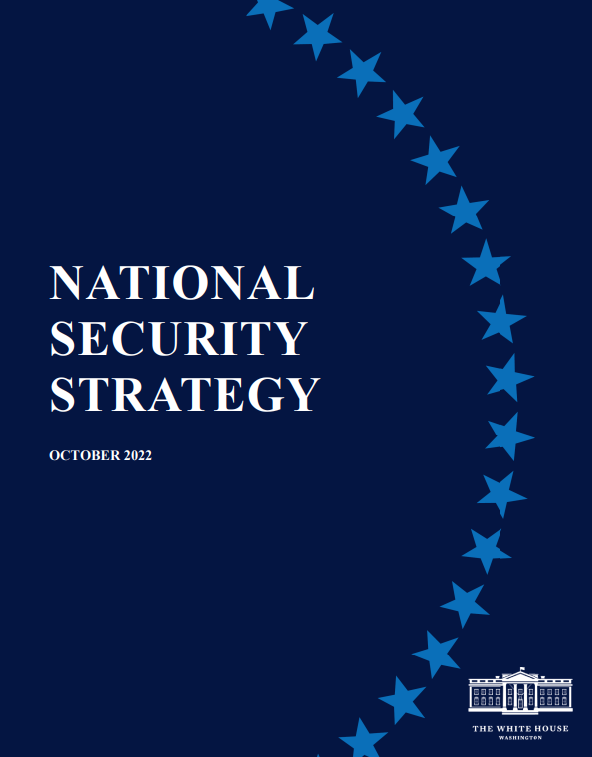
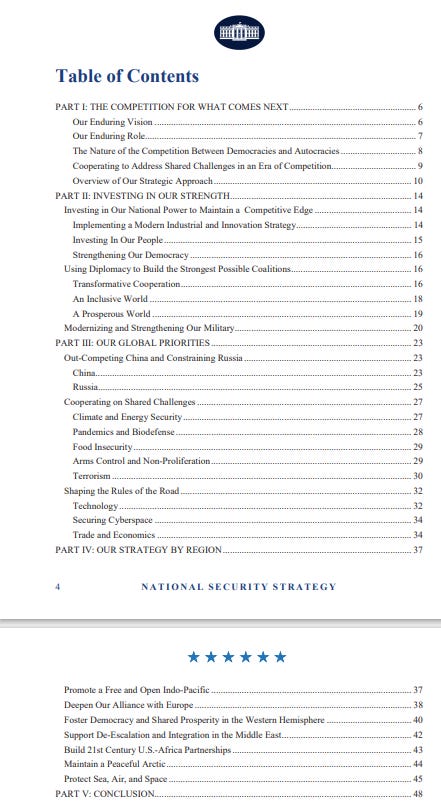
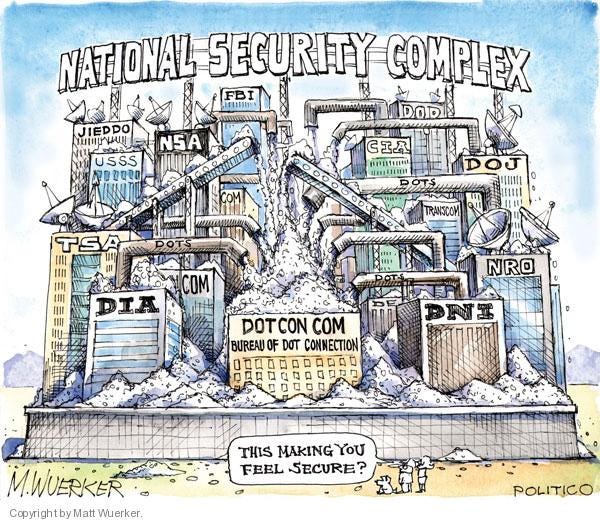



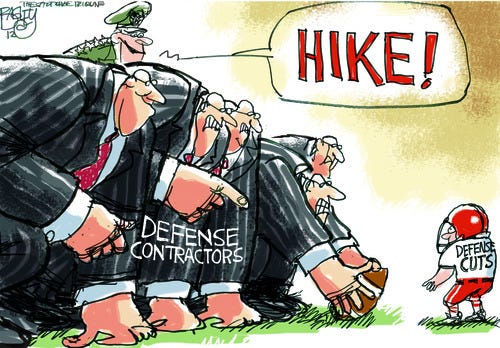

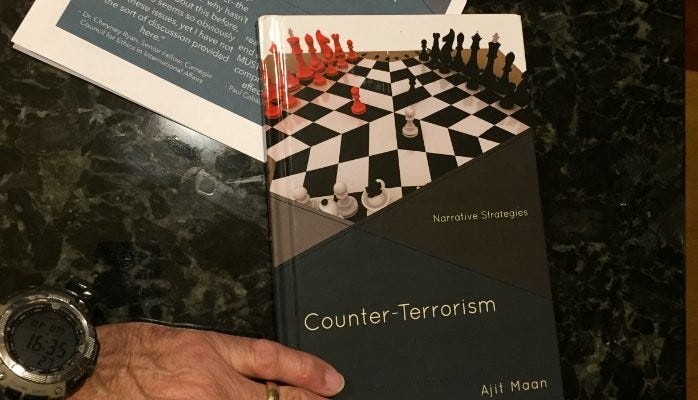
I work in local Government, State of Ca. water District manager, for thirty years and even down to the local level this is true. People simple refuse to stop and talk until they solve a problem, but spend millions to the same "Consultants" so they will solve problems, that if solved would leave them without work.